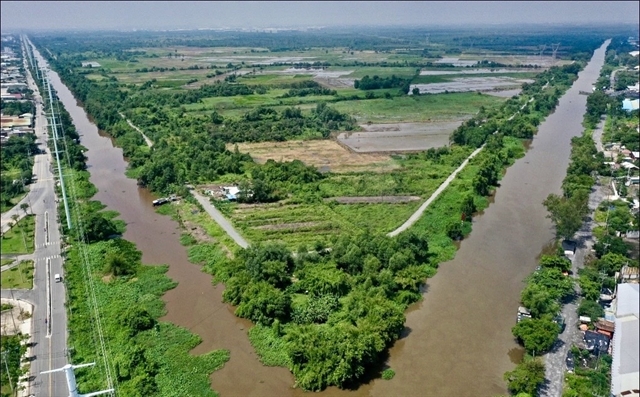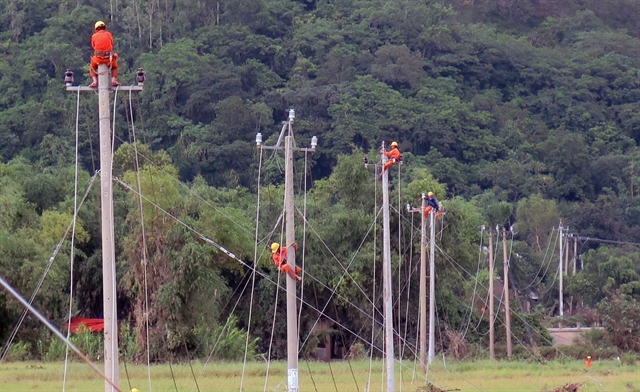 Society
Society


|
| Workers repair a breakdown on the electricity system in Đồng Xuân District, the central province of Phú Yên. — VNA/VNS Photo Xuân Triệu |
HÀ NỘI — The Ministry of Industry and Trade (MoIT) has announced ambitious plans to ensure 870,000 households in rural, mountainous and island areas have a stable electricity connection by 2025.
Some 153,000 households are set to get electricity for the first time, while a further 717,000 households will have their unstable supplies improved as part of the target programme for rural, mountainous and island electricity supply in the period 2021-25.
The target was revealed at a conference of the Department of Electricity and Renewable Energy under the MoIT held yesterday in Hà Nội.
The programme will also supply electricity to more than 2,600 small and medium-sized pump stations in 13 provinces in the Mekong Delta.
The move will supplement the national grid or provide renewable energy sources for islands like Cồn Cỏ Island in Quảng Trị Province, Thổ Chu, An Sơn and Nam Du in Kiên Giang Province, and Ninh Tân, Ninh Đảo and Diệp Sơn island villages in Khánh Hòa Province.
Speaking at the conference, Deputy Minister of Industry and Trade Đặng Hoàng An said providing electricity to rural areas was an important and outstanding achievement of Việt Nam, with electricity supplied to more than 17 million households in rural, remote, border and island areas.
In rural areas, the percentage of households using electricity as of December 31, 2019, reached 99.26 per cent, meaning only about 0.74 per cent of rural households lacked access to electricity.
The target programme for electricity supply for rural, mountainous and island areas in 2016-20 set a goal of supplying electricity from the national grid to the 17 communes without electricity, which are home to about 1,055,000 households in 9,890 villages and hamlets.
The programme achieved encouraging results and supplied power to all 17 communes, with a total of 204,737 households getting power, as did five islands including Lý Sơn, Bạch Long Vỹ, Nhơn Châu, Cù Lao Chàm and Cái Chiên.
An said that due to the limitations of financial resources, capital from the central budget for the programme only reached VNĐ4.7 trillion (US$204.7 million), including the reciprocal capital of investors, just 18.5 per cent of the total capital needs.
This meant the target of most rural households accessing electricity was missed.
Bùi Quốc Hùng, deputy director of the Department of Electricity and Renewable Energy, said that the goal for 2021-25 was to supply electricity to most rural households, but an additional VNĐ26 trillion ($1.1 billion) of investment capital was needed.
The total capital was very large, finding funding was a problem, he said, adding that Việt Nam has become a more developed economy so it no longer has access to concessional official development assistance (ODA) sources.
Therefore, the MoIT recommended that the Government report to the National Assembly to balance public debt, giving priority to seeking ODA loans and foreign concessional capital to supplement the central budget to implement the programme.
Võ Quang Lâm, deputy general director of Vietnam Electricity (EVN), said that by last year, EVN had provided and managed electricity sales to 11 out of 12 island districts and 82 out of 85 island communes with a total capital of more than VNĐ7.9 trillion ($342.2 million).
The supply of electricity to mountainous and island regions faced many difficulties in terms of geographical distance, the longevity of equipment and maintenance, he said.
Đặng Ngọc Hậu, deputy chairman of Sơn La Province People's Committee, said that up to now, 97.5 per cent of households in the province had electricity, greatly contributing to economic development, social security and poverty reduction.
On average, the number of poor households reduced by 3 per cent per year. However, Sơn La was still a poor province, so it would strive to bring the rate of households using electricity to 99.5 per cent, he said. — VNS




